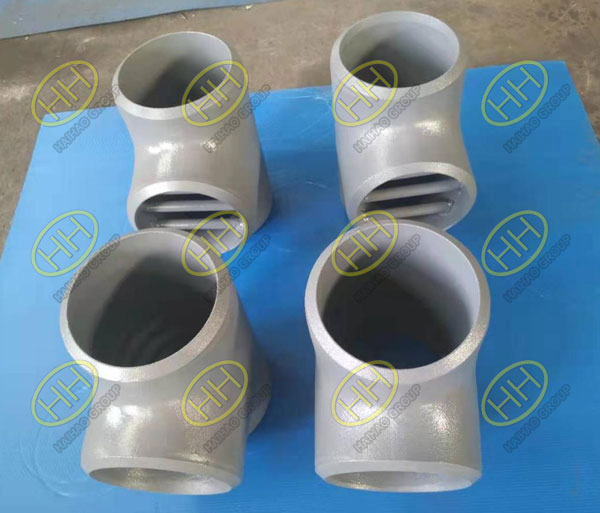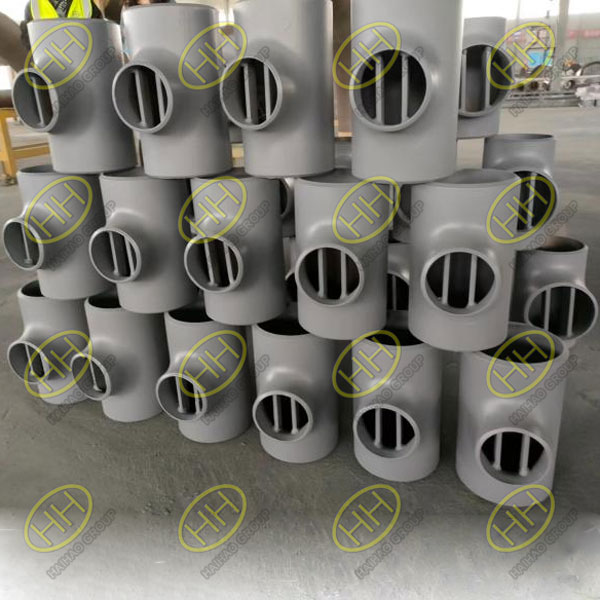The barred tees ordered by the Singapore customer completed the drift test and LPI test
At Haihao Group, we take quality assurance seriously, especially for specialized products like barred tees. For our valued Singapore client, we will be conducting two essential tests: the Drift Test and the Liquid Penetrant Inspection (LPI Test). These tests ensure that the barred tees meet the highest standards of reliability and safety required for their intended applications.

Barred Tees SCH80 Bevel Ends ASTM A860 WPHY65
Drift Test
The Drift Test is a crucial procedure to verify the internal continuity and smoothness of the pipe or fitting, ensuring that there are no obstructions or deformations that could impede fluid flow or cleaning devices.
Procedure:
Preparation: Select a drift plug with a diameter slightly smaller than the internal diameter of the barred tee.
Testing Process:
Insert the drift plug into one end of the barred tee.
Push or pull the drift plug through the entire length of the tee.
Ensure that the drift plug moves smoothly without any obstruction or getting stuck.
Evaluation:
If the drift plug passes through the tee without any issues, the test is considered successful, indicating that the internal diameter is free of significant deformations or blockages.
If the drift plug encounters any obstructions, further inspection is necessary to identify and rectify any deformations, weld protrusions, or other defects.

barred tees
Liquid Penetrant Inspection (LPI Test)
The Liquid Penetrant Inspection (LPI), also known as dye penetrant inspection, is a non-destructive testing method used to detect surface-breaking defects such as cracks, porosities, and other flaws that might compromise the integrity of the barred tee.
Procedure:
Surface Preparation:
Clean the surface of the barred tee thoroughly to remove grease, dirt, and other contaminants. This step ensures that the penetrant can effectively enter any surface defects.
Application of Penetrant:
Apply the penetrant (a colored or fluorescent liquid) evenly over the test surface.
Allow the penetrant to dwell on the surface for a specified period (typically 5-30 minutes) to enable it to seep into any surface flaws.
Removal of Excess Penetrant:
Carefully remove the excess penetrant from the surface using clean, dry cloths or paper towels, followed by a cleaner.
Application of Developer:
Apply a developer (usually a white powder) to the surface. The developer helps draw the penetrant out of the defects and creates a visible indication.
Inspection and Evaluation:
Inspect the surface under appropriate lighting conditions (natural light for colored penetrants, UV light for fluorescent penetrants).
Look for visible indications of defects, which appear as colored or fluorescent marks on the developer background.
Evaluate the size, number, and location of the defects to determine the quality and integrity of the barred tee.
Importance of These Tests
Drift Test: Ensures that the internal passage of the barred tee is smooth and unobstructed, which is critical for maintaining fluid flow and the operation of cleaning devices like pigs.
LPI Test: Detects surface defects that could compromise the structural integrity of the barred tee. This test is essential for identifying small cracks and porosities that might not be visible to the naked eye.
By conducting the Drift Test and Liquid Penetrant Inspection, Haihao Group ensures that the barred tees ordered by our Singapore client meet the highest standards of quality and reliability. These rigorous tests confirm that our products are free from internal obstructions and surface defects, providing our clients with the confidence they need in the performance and safety of their piping systems.

